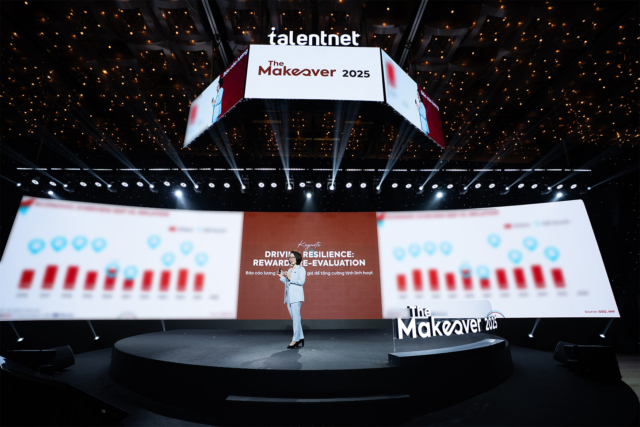5 Insights Forcing Businesses to Rethink Their 2026 People Strategy

Nov 3, 2025
Last updated on Nov 3, 2025
At The Makeover 2025, Talentnet unveiled key highlights from the Talentnet Salary Report 2025, spotlighting 5 critical data points that may urge businesses to rethink their current pay and reward strategies - especially in the age of AI transformation.

According to Ms. Nguyen Thi Quynh Phuong, Head of Human Capital Solutions, Talentnet, in the age where AI is redefining how businesses operate, compensation is no longer just about numbers – it is a strategy for sustainable and human-centered growth. Below are 5 key data points from this year’s Talentnet Salary Report 2025 – figures that may prompt many businesses to reconsider how they design and manage their reward strategies.
Data #1: 47.7% of companies prioritize stability to strengthen internal capability
According to the Talentnet – Mercer 2025 Report, 47.7% of companies plan to maintain their current headcount, while only 35% expect to expand their workforce in the coming year. Meanwhile, the proportion of businesses that have not yet decided on their 2026 hiring plans has risen sharply to 10.6%. This trend of “staying stable to strengthen from within” reflects a cautious mindset among businesses, as global economic uncertainties continue to loom.
At the same time, the average turnover rate continues to decline – down to 6.6% among multinational companies (MNCs) and 9.8% among local enterprises, indicating a renewed sense of employee commitment. However, instead of viewing this as a sign of “safety,” Ms. Phuong believes now is the right time for businesses to comprehensively reassess their compensation structures. “Businesses need to clearly identify their ‘hard core’ – the stable workforce they must retain – and their ‘soft core,’ the flexible workforce that can be adjusted as needed. Flexibility should not only apply to HR policies, but also to leadership mindset,” Ms. Phuong emphasized.
Data #2: Gen Z up by 2.5%, Baby Boomers stay in leadership – The succession challenge at the top
Gen Z now accounts for 32% of the workforce, up by 2.5% compared to 2024. Meanwhile, the proportion of Baby Boomers in senior leadership roles has increased by 3.1%.
Although their retention rate dropped from 15.9% to 14.4% due to retirement, the number of Baby Boomers holding key executive positions continues to rise. This highlights a succession gap within organizations – younger employees are not yet ready to take on leadership roles, forcing many seasoned leaders to stay longer in their positions. Now is the time for businesses to strengthen succession planning strategies – creating space for younger generations to grow while leveraging the experience and wisdom of senior leaders.

Gen Z is leading the youth-driven transformation of Vietnam’s workforce.
At the same time, this demographic shift urges businesses to redesign their benefits strategy toward personalized rewards, leveraging data and employee behavior analytics. For example, Gen Z prioritizes learning and growth experiences, Gen Y values work-life balance, while Gen X focuses on insurance and long-term benefits. From these insights, Ms. Phuong emphasized that data only becomes meaningful when it is transformed into understanding – and action.
Data #3: Salary increases hit a 10-year low – bonuses emerge as the key lever to retain top talent
In 2025, the average salary increase in Vietnam reached its lowest level in a decade, reflecting growing caution amid global economic uncertainties. The average salary increase among multinational companies (MNCs) dropped to 6.3%, lower than during the COVID-19 period (7% in 2022), while local companies reported an increase of 6.2%. Notably, local firms no longer outpace MNCs in salary growth – a sign that Vietnamese businesses are also tightening their spending.
Despite slower salary growth, companies have maintained stable bonus levels – 15.9% at MNCs and 19.7% at local firms, closely aligned with employee expectations. This indicates a clear shift from fixed salary increases to performance-based rewards, as businesses seek to compensate for slower wage growth and retain top talent.

Ms. Quynh Phuong shared an overview of the labor market landscape at The Makeover 2025.
Data #4: Female leadership on the rise, gender pay gap on the decline.
The report also highlights positive progress toward gender equality: the proportion of female leaders in MNCs has increased to 43.2%, and the gender pay gap is gradually narrowing.At certain levels, women’s base salaries are 9–16% higher than men’s, yet their total income remains 3–17% lower due to differences in bonus structures and job distribution.
To foster a fair and sustainable workplace, businesses are encouraged to regularly review pay data, disclose promotion and reward criteria, and benchmark against trusted market reports to ensure transparency and competitiveness in compensation policies. “Equality is not just a slogan – it is a long-term talent retention strategy. A fair compensation system strengthens trust, which is the most critical competitive advantage in the age of AI,” Ms. Phuong emphasized.
Data #5: Future skills on the rise – companies are paying for the ability to learn.
According to the report, industries that are heavily investing in technology, data, and digital transformation – such as Finance & Banking, Real Estate, and High-Tech – are offering the highest salaries in the market. This reflects a new reality: in the age of AI, performance is defined by adaptability and creative thinking.
Businesses should start investing in future skills – including data analytics, AI literacy, creative thinking, and agile leadership – rather than simply increasing salaries mechanically. As productivity is being redefined, reward strategies must also evolve. “Performance is no longer about working harder, but working smarter. Companies should pay for the ability to learn – because that’s the one skill that can’t be replaced,” Ms. Phuong emphasized.

Continuous learning is the most essential skill employees need in the age of AI.
When compensation and reward strategies are data-driven, technology-enabled, yet human-centered, businesses can find the balance between efficiency and empathy, between growth and engagement – in an era where change is the only constant. Businesses can access Vietnam’s largest salary database and receive practical insights for building flexible pay strategies through the 2025 Vietnam Total Remuneration Survey, conducted by Talentnet in partnership with Mercer. The report features data from 678 organizations, including 606 multinational companies and 72 local enterprises.

Solve your HR problems!
6th Floor, Star Building, 33 Mac Dinh Chi, District 1, Ho Chi Minh City, Vietnam




